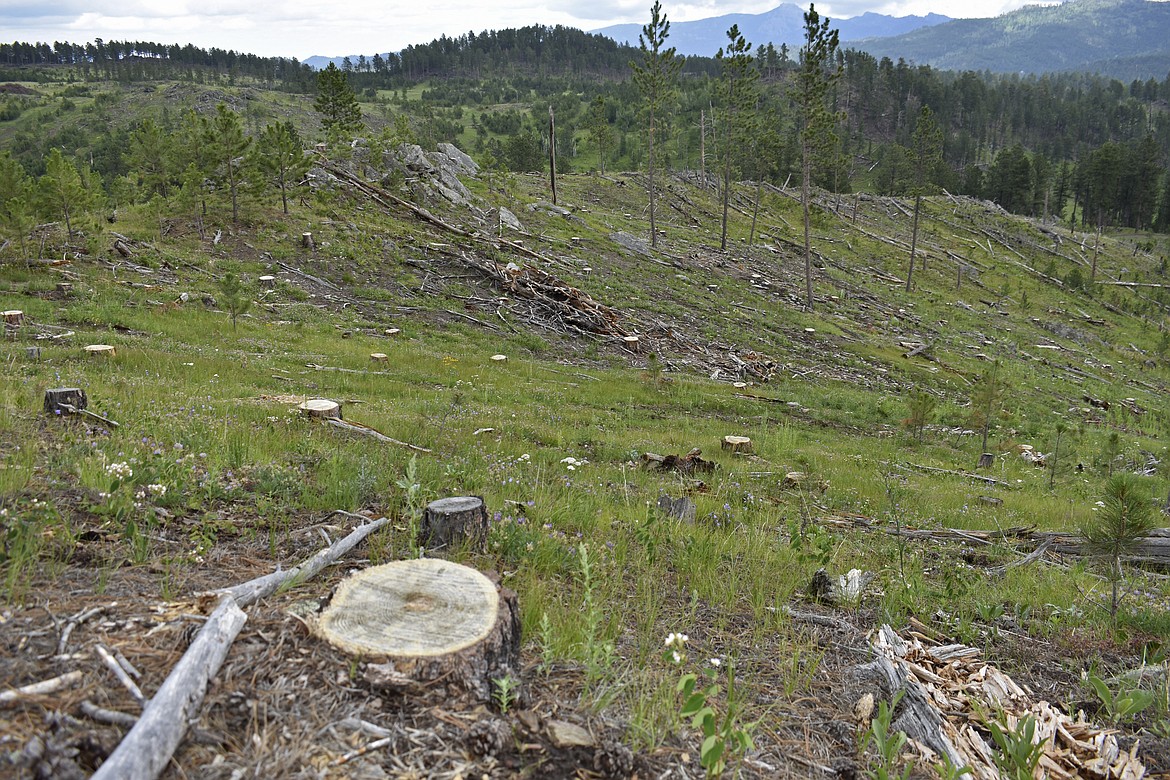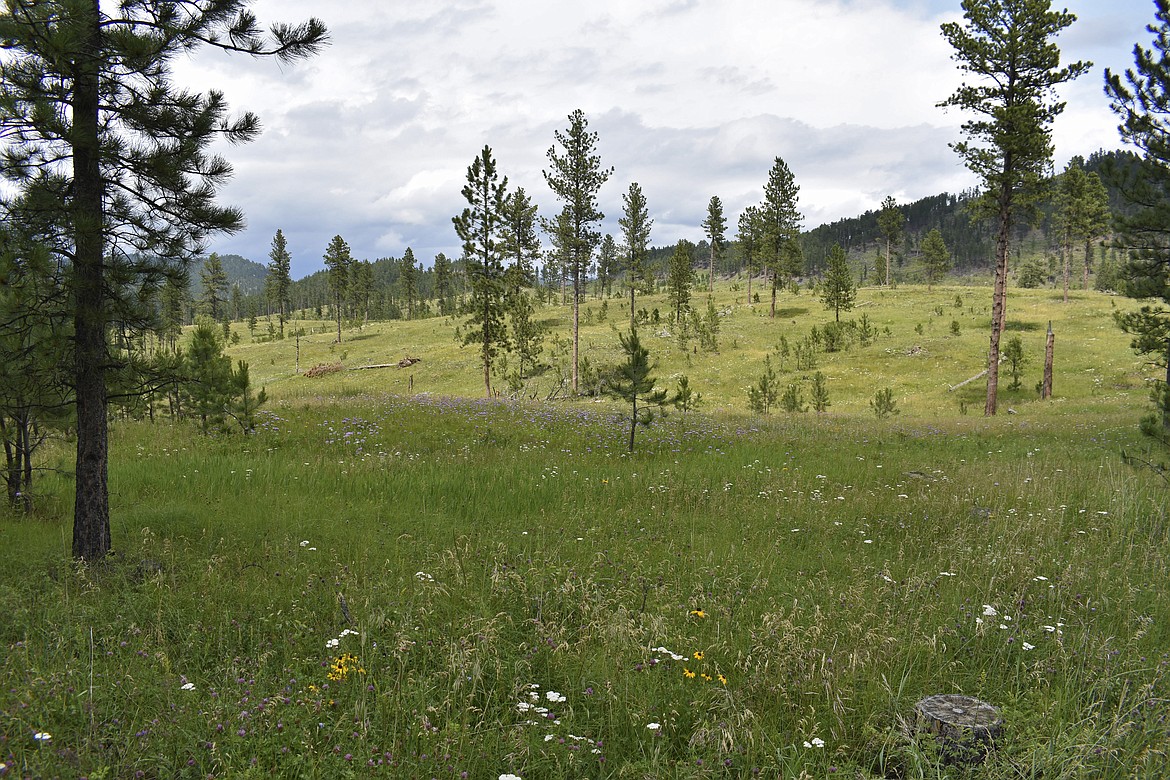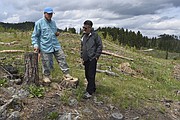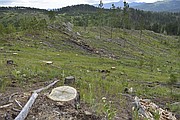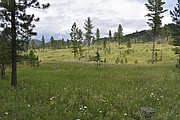Climate change, logging collide — and a forest shrinks
CUSTER CITY, S.D. (AP) — Looking down a hillside dotted with large stumps and nearly devoid of trees, a pair of retired U.S. Forest Service employees lamented logging policies they helped craft to deal with two harbingers of climate change -- pine beetles and wildfires.
Timber production dramatically ramped up two decades ago in the Black Hills National Forest along the South Dakota-Wyoming border, as beetles ravaged huge expanses of forest and worries grew over wildfires.
The beetles left, but the loggers haven't — and they're now felling trees at twice the rate government scientists say is sustainable. That means the Black Hills forests are shrinking, with fewer and smaller trees.
Timber sales from federal forests nationwide more than doubled over the past 20 years, according to government data. In Washington, D.C., Republicans and Democrats alike have pushed more aggressive thinning of stands to reduce vegetation that fuels wildfires.
But critics of federal forest management say that in their fervor to do something about climate change, officials are allowing the removal of too many older trees that can actually better withstand fire.
In the Black Hills, stands of century-old ponderosa pines were thinned over the past two decades, then thinned again. In some areas, most of the remaining older and larger trees are being cut, leaving hillsides almost bare.
"Eventually you're not going to have any big trees on the whole forest," said Dave Mertz, who worked as a government natural resources officer overseeing Black Hills logging until retiring in 2017. "The timber industry is pulling the strings now. The Forest Service has lost its way."
DIRE PREDICTIONS
Across the western U.S., more trees have been dying as climate change dramatically alters the landscape and leaves forests more susceptible. Wildfires, insects and disease are the top killers, researchers say.
A sweeping government review of forest health surveys since 1993 found that the rate of trees dying increased this century and outpaced new growth in all eight states examined — Arizona, Colorado, Idaho, Montana, Nevada, New Mexico, Utah and Wyoming. Timber harvested from Forest Service lands over the past two decades also increased.
In the Black Hills, those two trends have collided. With more trees being logged and even more killed by beetles and fires in recent years, government scientists say the forest can't grow fast enough to keep up.
The timber industry and allies in Congress are pushing back against that conclusion. Timber company representatives predict dire economic consequences if forest managers sharply reduce harvest levels. And they say wildfires and beetle outbreaks would get worse.
One of the region's seven mills closed in March, eliminating 120 jobs in Hill City, South Dakota. Owner Neiman Enterprises said a recent slowdown in timber sales meant it wouldn't have enough logs.
"These companies aren't tech startups. They are multi-generational family companies that want to be there for the long term." said Ben Wudtke, director of the Black Hills Forest Resource Association of saw mills and logging companies.
FIGHTING FIRE
To counter growing havoc from western wildfires, Biden's administration wants to double the forest acreage thinned or treated with prescribed burns to 6 million acres (2.4 million hectares) annually — bigger than New Hampshire.
One method to reduce fire risk is to remove dense stands of small trees and thick underbrush that accumulated for decades as wildfires — a natural part of the landscape — were suppressed.
It's expensive, labor-intensive work, and there's little market value in small trees. When sworn in this summer, Forest Service Chief Randy Moore said combating climate change will require making it worthwhile to harvest smaller trees, such as using the vegetation as biomass to generate electricity.
"It doesn't pay for itself and we don't have markets that seem to be increasing quickly enough," he said.
The service's former deputy chief, Jim Furnish, criticized the agency as too focused on timber production and too slow to react to climate change, to the detriment of the forest.
There are signs of change under President Joe Biden, including the administration's move last month to end large-scale commercial logging of old-growth trees in Alaska's Tongass National Forest.
But other projects that include old-growth removal are pending, including in Montana's Kootenai National Forest along the Canada border, the Kaibab National Forest just north of the Grand Canyon in Arizona and Idaho's Nez Perce-Clearwater National Forest.
"The Forest Service's approach to date has been to attack this as a management problem: 'We need to cut more trees,'" Furnish told The Associated Press. "You can't cut your way out of this problem."
Moore, the agency's chief, acknowledged the warming planet was forcing changes, but said he hoped to find a "sweet spot" between the environment and industry — while removing enough vegetation to reduce wildfire risk. In the Black Hills, officials said they would consider the latest science alongside economic impacts as they seek to make logging sustainable.
"We need the industry to help us," Moore said, referring to climate change. "It's not really about timber sales or cutting large trees."
"BEAT TO HELL"
The Black Hills played an outsized role in the early formation of the nation's timber policies. In the 1890s, excessive logging to feed demand for timbers for a nearby gold mine helped spur creation of the national forest system. The first regulated logging sales in forest service history took place there in 1899.
When artist and environmentalist Mary Zimmerman bought property within the Black Hills in 1988, neighboring public lands where that first timber sale took place had regrown so successfully that huge branches overhead "were like a cathedral."
The site was thinned in 1990, removing some big trees but leaving many. It was thinned more in 2016. Then logging crews returned last year and took out the remaining big trees. Cattle now graze the area.
"It's just beat to hell," said Zimmerman.
Her account was confirmed by Blaine Cook, forest management scientist for the Black Hills for more than two decades until his 2019 retirement.
EARLY WARNINGS
Cook said his monitoring began to show last decade that the forest's growth rate wasn't keeping up with aggressive logging that was a response to the pine beetle outbreak that began in 1998. The high harvest rate continued after the outbreak peaked in 2012 and even after it ended in 2017.
Cook said his warnings that the forest was being damaged were rejected by superiors who faced political pressure to provide a steady supply of logs to sawmills in South Dakota and Wyoming.
Disagreement within the agency over whether there was too much logging culminated in a report this April by scientists from the forest service's research branch that was unequivocal: Black Hills logging needs to be cut back by at least half, possibly more, to be sustainable.
The problem is that the forest changed but logging rates have not, said Mike Battaglia, one of the lead authors.
"In the late 90's, you had twice as much volume" of trees in the forest, he said. "To take out the same amount now, you're taking too much."
Forest industry representatives criticized the government's multi-year study for including only parts of the forest, saying that created an incomplete picture of how many trees are available to harvest.
They estimated up to 80% of the region's timber industry jobs would be lost if the forest service reduced logging to recommended levels. If that happens, they said the agency would have difficulty finding companies willing to do less profitable thinning work for wildfire protection.
"You have to have somebody around to do it," said the forest industry's Wudtke. "It's really critical that we keep these companies going."
The Associated Press Health and Science Department receives support from the Howard Hughes Medical Institute's Department of Science Education. The AP is solely responsible for all content.




